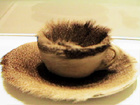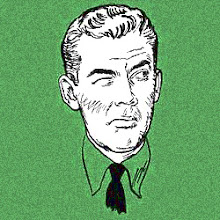 In his semi-bombshell New York Times Book Review essay** about the new American poets generally - the piece was written in 1960 but published in the February 21, 1961 newspaper - Kenneth Rexroth said that the new poets owe more to the example of Apollinaire or Lorca than to the T. S. Eliot giving speeches about the English Metaphysicals. (Yes.) He said that for better or worse the doings of poets were once again momentarily "hot copy for newspapers and magazines." This was because of a myth about the new poets--a myth, he felt, promulgated by the Beats, whom he somewhat dismisses as a PR phenomenon: myth-making about not poetry but the image of the poet as "Bearded Barbarian" (the title of the essay is "Bearded Barbarians or Real Bards").
In his semi-bombshell New York Times Book Review essay** about the new American poets generally - the piece was written in 1960 but published in the February 21, 1961 newspaper - Kenneth Rexroth said that the new poets owe more to the example of Apollinaire or Lorca than to the T. S. Eliot giving speeches about the English Metaphysicals. (Yes.) He said that for better or worse the doings of poets were once again momentarily "hot copy for newspapers and magazines." This was because of a myth about the new poets--a myth, he felt, promulgated by the Beats, whom he somewhat dismisses as a PR phenomenon: myth-making about not poetry but the image of the poet as "Bearded Barbarian" (the title of the essay is "Bearded Barbarians or Real Bards"). The new poets were political in their frankness, their independence of mind, their non-academicism, and their intellectual affiliations with the world ("American poetry is once more a recognizable part of world poetry").
They're more socially conscious than the preceding era's poets and at the same time also more willing to "sacrifice all for Art."
Rexroth felt that Denise Levertov was the best of the lot.
"Second only to Denise Levertov is Robert Creeley." Rexroth lavishes praise on Creeley. His poems superficially fall in the William Carlos Williams category but they "turn out to be anything but Imagist." "They are all [sic] erotic poems."
And this good line: "Each [poem] is an excruciating spasm of guilt."
Then Rexroth goes on to talk about Charles Olson. While he doesn't call him third on the list behind Levertov and Creeley, it's pretty clear that that's what he means. (One can just imagine how Olson felt about that implication.)
 I realize that it is or at least was once the custom of those who design NYTBR that an illustration is always placed somewhere on the front page. Sometimes the drawing or photo has nothing whatever to do with the lead review. Perhaps in this case it doesn't either. And yet the choice to use a modernist wood sculpture by Barbara Hepworth had to lead readers to believe a relationship between the image of Rexroth's survey of contemporary avant-garde poetry was being meant. Especially because the sculpture is a biomorphic lyre. Are poets returning to the age-old responsibilities and song-singing of Western poetic tradition? Actually, in a way, Rexroth is saying yes. But he is also saying that the new American poets are getting beyond modernism - that Eliot's influence is waning, that the "social role" of the poet, long an agonizing question for first-generation modernists, is a comfortable one for these young writers. So what were the NYTBR editors consciously or half-consciously expressing by way of illustrating Rexroth with the Hepworth sculpture?
I realize that it is or at least was once the custom of those who design NYTBR that an illustration is always placed somewhere on the front page. Sometimes the drawing or photo has nothing whatever to do with the lead review. Perhaps in this case it doesn't either. And yet the choice to use a modernist wood sculpture by Barbara Hepworth had to lead readers to believe a relationship between the image of Rexroth's survey of contemporary avant-garde poetry was being meant. Especially because the sculpture is a biomorphic lyre. Are poets returning to the age-old responsibilities and song-singing of Western poetic tradition? Actually, in a way, Rexroth is saying yes. But he is also saying that the new American poets are getting beyond modernism - that Eliot's influence is waning, that the "social role" of the poet, long an agonizing question for first-generation modernists, is a comfortable one for these young writers. So what were the NYTBR editors consciously or half-consciously expressing by way of illustrating Rexroth with the Hepworth sculpture? Implicitly: Bearded barbarians or whatever.... Play things as they are.
** February 12, 1961, pp. 1, 44.

 Is '60 the moment when the end of the end of the Old Left had been reached and the New Left began to emerge? Is it the final ascendancy, in certain scenes at least, of poetic postmodernity? Surely the publication of Donald Allen's The New American Poetry that year suggests this, but then again--once again--we look back on "New" here and see continuity. The rhetoric of the Kennedy-Nixon contest made much less of a dent than everyone (at the time as well as since) claimed, so one wonders why were such great claims made?
Is '60 the moment when the end of the end of the Old Left had been reached and the New Left began to emerge? Is it the final ascendancy, in certain scenes at least, of poetic postmodernity? Surely the publication of Donald Allen's The New American Poetry that year suggests this, but then again--once again--we look back on "New" here and see continuity. The rhetoric of the Kennedy-Nixon contest made much less of a dent than everyone (at the time as well as since) claimed, so one wonders why were such great claims made?  Had we come to expect "1960" to be truly ubiquitously modern in a way that the 1950s really were not--not quite? And what specifically does "modern" mean in the Kennedyesque talk then and now about the torch being passed to a new generation, etc.? The First Lady really meant "modernist" when Camelotians said "modern." What about the others across the new young cultural leadership? I've been surprised by how frequently the
Had we come to expect "1960" to be truly ubiquitously modern in a way that the 1950s really were not--not quite? And what specifically does "modern" mean in the Kennedyesque talk then and now about the torch being passed to a new generation, etc.? The First Lady really meant "modernist" when Camelotians said "modern." What about the others across the new young cultural leadership? I've been surprised by how frequently the  "Beat movement" was covered in 1960 in the mainstream press. I was expecting a fair measure but I've found tonnage. 1960 was the year when the figure of the beat was beginning to find acceptance, although still 80% of these stories are mocking, rebels-without-cause condescension. For anyone whose analysis made an impact nationally, do these antipolitical adolescents count as part of the "new young cultural leadership"? No, but rather than the two being opposites, they fall along a Continuum of the New American. Now that's a change for '60.
"Beat movement" was covered in 1960 in the mainstream press. I was expecting a fair measure but I've found tonnage. 1960 was the year when the figure of the beat was beginning to find acceptance, although still 80% of these stories are mocking, rebels-without-cause condescension. For anyone whose analysis made an impact nationally, do these antipolitical adolescents count as part of the "new young cultural leadership"? No, but rather than the two being opposites, they fall along a Continuum of the New American. Now that's a change for '60.







